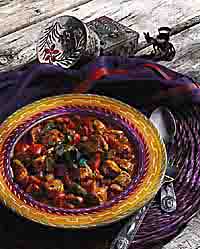Stewed Turkey with Herbs and Onions
 Published in Epicurious | October 2005
Published in Epicurious | October 2005
by Kathleen Curtin, Sandra L. Oliver, and Plimoth Plantation
If you have never thought to boil a turkey, this 1623 recipe will make a believer out of you. While the original recipe calls for a whole bird, the modern recipe is adapted to use with prepackaged turkey pieces. If you would like use a small whole bird (10-12 pounds), cut it into ten pieces before boiling—it is really difficult and potentially dangerous to lift a whole steaming turkey from a pot of boiling broth. For this larger amount of turkey, you will need to double the other ingredients.
4 pounds turkey parts (thighs and legs work well for this recipe)
2 large onions, sliced into 1/4-inch rings
1 teaspoon salt
Bundle of fresh herbs, tied (any combination of the following are appropriate: sage, thyme, parsley, marjoram, or savory), or 2 tablespoons dried
1/3 cup red wine vinegar or cider vinegar
2 tablespoons (1/4 stick) salted butter
2 tablespoons sugar
1 teaspoon black peppercorns
6 to 8 (1-inch-thick) slices of hearty bread, cut in half and toasted or fried until browned
1/4 teaspoon ground cloves
Rinse the turkey pieces and place them in a pot large enough to accommodate them. Cover with cold water and add the salt. Cover the pot and bring the contents to a boil over medium-high heat. Reduce the temperature to keep the broth at a low simmer for 1 hour. Periodically, skim any froth that rises to the surface.
After an hour, remove the turkey pieces and set aside to cool. Raise the heat until the broth comes to a boil. Continue boiling, uncovered, until the liquid is reduced by half. (This will take about an hour.)
When the broth is reduced, add the sliced onions, herbs, vinegar, butter, sugar, peppercorns, and cloves. Simmer for about 20 minutes, until the onions are soft. While the broth is simmering, cut the cooled turkey into serving pieces.
Before serving, taste the broth and adjust the seasoning. Place the meat into the broth and "let it take a walme or two," that is, let it simmer gently for just a minute. Pour the turkey and sauce into a serving bowl. Pass the "sippets" (toasted bread slices) to serve as a base for the turkey and to sop up the sauce.

Article published in Archaeology Magazine by the Archaeological Institute of America.
| From the President: Talking Turkey | Volume 57 Number 6 |
| by Jane C. Waldbaum | |
Food for thought this Thanksgiving
During the holiday season, most people's thoughts naturally turn to food. As an archaeologist, however, I am almost as interested in the origins of our feasts as I am in partaking of them. And the turkey, which may well appear on your own festive dinner table, has a fascinating archaeological and zoological past.
The turkey originated in North America. Ice Age turkey bones have been found from Florida to New Mexico. A.W. Schorger, who wrote the standard work The Wild Turkey: Its History and Domestication in 1966, suggests that turkeys were domesticated in Mexico some time between 200 B.C. and A.D. 700 and had spread through Central America and parts of South America by the time of the Spanish conquest. A second, apparently independent area of domestication is in the American Southwest around A.D. 200 in the Mogollon culture of New Mexico and A.D. 400 in the Anasazi of Arizona.
Turkeys appear in the artwork of many ancient cultures. The Maya painted or modeled turkeys--distinguished by the wattle falling down the front of the face and by bumps on the headÑon many vases from around A.D. 250 to 800, notes University of Wisconsin-Milwaukee art historian Andrea Stone. "For the Maya," she adds, "turkeys were quintessential animals for feasting and for sacrificial offerings." They even made turkey-shaped tamales! And in the Southwest, the birds appear as painted designs on Mimbres pottery a thousand years ago.
The Spanish conquistadors, including Cortés (1519), were greeted by the local people with plenty of turkey and other delicacies. Ambassadors from the Aztec ruler Montezuma are said to have presented Cortés with six golden turkeys (no doubt soon melted down!). The Spanish must have liked what they tasted, because they shipped turkeys back to Spain as early as 1511. From there the turkey spread rapidly through western Europe and, in a delicious twist, English, French, and Dutch colonists brought this bird back to eastern North America in the early seventeenth century, where it interbred with wild turkeys to become the ancestor of the modern holiday gobbler. The Pilgrims, who, according to the apocryphal story, ate wild turkey at the first Thanksgiving, would likely have been familiar with the domestic variety before leaving Europe.
Jean Hudson, a zooarchaeologist at UW-Milwaukee, says she studies animal remains "to better understand past human behaviors and beliefs." As she sees it, the story of the peripatetic turkey is a wonderful example of "how complex the relationship between humans and animals can be." As we sit down to our holiday feasts, let us remember the remarkable story of what Ben Franklin described, in a letter to his daughter, as a "respectable Bird, and withal a true original Native of America." Pass the drumstick!
Jane C. Waldbaum is the president of the Archaeological Institute of America.
The article can be found on-line at:  http://archive.archaeology.org/0411/etc/president.html
http://archive.archaeology.org/0411/etc/president.html
